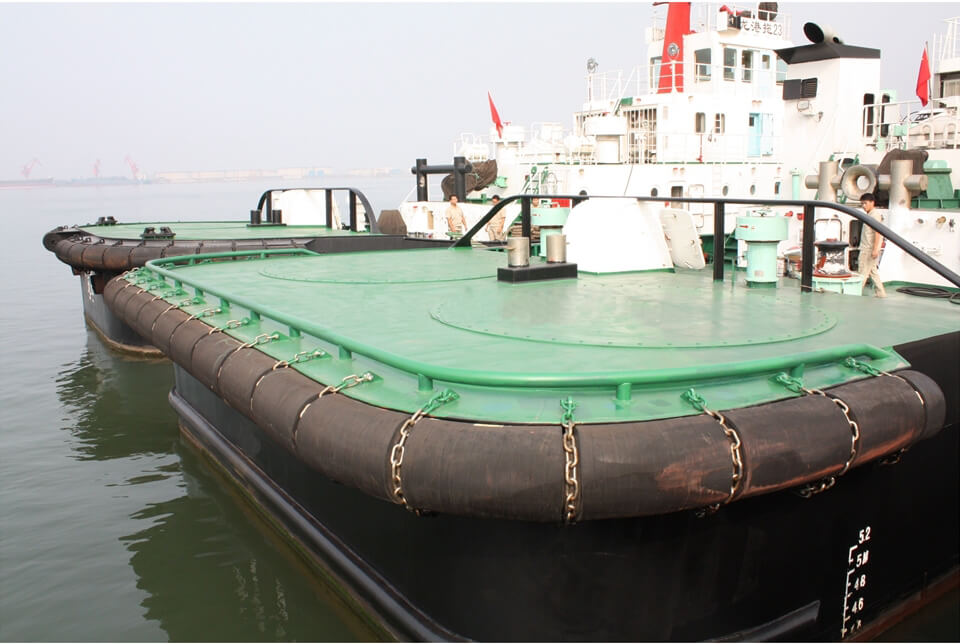Maritime engineering relies significantly on the indispensable role played by rubber fenders, serving as a protective shield between vessels and structures during berthing or mooring operations. The primary objective of rubber fenders is to absorb kinetic energy, mitigating potential damage to both the vessel and the supporting infrastructure. This necessitates the utilization of various mechanisms and technologies aimed at optimizing the energy absorption capabilities of rubber fenders. This article delves into the crucial mechanisms and technologies employed in the design and construction of rubber fenders to ensure efficient energy absorption.

Material Selection and Composition for Energy Absorption
The performance of rubber fenders hinges on the meticulous selection of materials. High-quality synthetic rubber compounds, including EPDM (Ethylene Propylene Diene Monomer) and SBR (Styrene Butadiene Rubber), are extensively employed for their durability, suppleness, and resilience to environmental factors such as UV radiation and salinity. The composition of these materials is carefully tailored to achieve the necessary balance of stiffness and flexibility for optimal energy absorption.
Cellular Rubber Fenders for Energy Absorption
A key design approach involves incorporating a series of cells within the rubber fender structure. These cells, filled with air and interconnected, facilitate a uniform stress distribution, thereby enhancing energy absorption capabilities.
Conical Design and Tapered Ends for Energy Absorption
Many rubber fenders adopt a conical design, characterized by a gradual increase in diameter from one end to the other. This cone rubber fender promotes a smoother energy absorption process. Additionally, the incorporation of tapered ends reduces the reaction force exerted on the vessel during berthing, contributing to safer and more controlled mooring operations.

Load Distribution and Performance Monitoring for Energy Absorption
To ensure even force distribution during vessel contact, rubber fenders integrate load distribution devices. This preventative measure prevents localized stress concentrations, enhancing the overall lifespan and performance of the fender. Furthermore, modern rubber fenders may include monitoring systems for real-time assessment of factors such as compression, temperature, and wear. This data aids in proactive maintenance and replacement planning.
Innovative Materials and Technologies in Rubber Fenders for Energy Absorption
High-Performance Rubber Compounds:
Natural Rubber Blends: Advances in blending natural rubber with synthetic rubbers or additives enhance strength, elasticity, and resistance to environmental factors.
High-Performance Elastomers: Development of elastomers with superior mechanical properties contributes to overall fender effectiveness.
Foam-Filled Fenders:
Closed-Cell Foam Technology: Utilizing closed-cell foam cores provides excellent energy absorption and low reaction forces during impact, enhancing buoyancy and reducing the risk of sinking.
Polyurethane Foams: Advanced polyurethane foams offer improved durability and resilience, suitable for demanding marine environments.
Fiber-Reinforced Composite Materials:
Incorporation of Aramid or Carbon Fibers: Adding high-strength fibers enhances structural integrity and energy absorption capabilities, leveraging excellent strength-to-weight ratios.
Composite Fender Panels: Some fender systems incorporate composite materials with layers of rubber and reinforcing fibers, striking a balance between flexibility and strength.

Smart Fender Technologies:
Sensor Integration: Integration of sensors, such as pressure sensors or strain gauges, enables real-time monitoring for predictive maintenance and optimized port operations.
IoT Connectivity: Internet of Things (IoT) technologies allow remote monitoring and management, enhancing overall safety and efficiency in port operations.
Sustainable Materials:
Recycled Rubber: Incorporating recycled rubber aligns with sustainability goals, maintaining or improving fender performance while reducing environmental impact.
Bio-Based Materials: Exploring bio-based rubber alternatives contributes to the development of eco-friendly fender materials.
Advanced Manufacturing Techniques:
3D Printing: Additive manufacturing techniques, such as 3D printing, provide innovative possibilities in designing complex fender shapes for optimized energy absorption.
Molded-In Features: Advanced molding techniques enable the incorporation of specific features, such as grooves or patterns, improving the fender’s performance under different impact scenarios.
Conclusion
The mechanisms and technologies employed in rubber fenders for energy absorption are diverse and continually advancing. The meticulous selection of materials, thoughtful design considerations, and integration of modern technologies collectively contribute to the effectiveness and reliability of rubber fenders in safeguarding vessels and infrastructure during berthing and mooring operations. As the marine industry progresses, the anticipation lies in the continual improvement of materials and technologies, ensuring enhanced safety and sustainability in port operations.